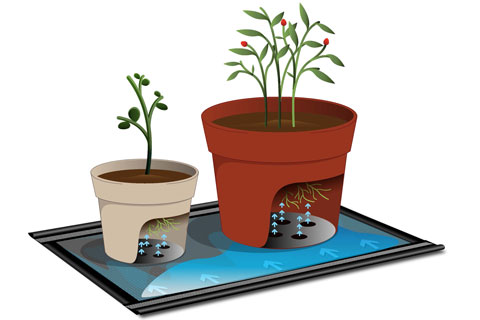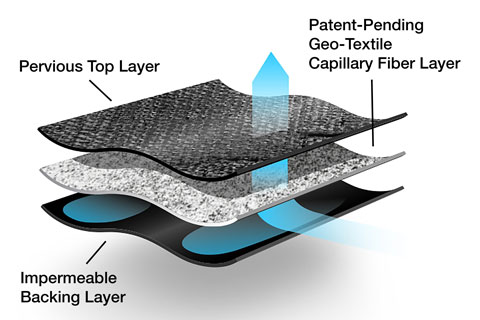11/1/2017
Going to the Mat
Kerstin Ouellet

Capillary mats for production make perfect sense for water and labor savings, but what about at the retail level? Turns out there’s as much to be gained at store level, from aesthetics and convenience to quality improvements and, of course, savings in labor and water. In fact, studies show up to 71% water savings—and the garden centers we talked with say the numbers are likely higher.
“We’re saving a ton of water and saving a fair amount of labor,” says Jason Innis, general manager of Van Atta’s in Haslett, Michigan, who’s using capillary mats from WaterPulse. “The water savings [with mats] has got to be 90% (we’re on a well so it’s hard to measure exactly). And you’re not losing any of the water—there’s virtually no runoff, so from an environmental standpoint, it’s better, too.”
Van Atta’s converted 80% of their perennial yard to capillary mats; it was successful enough that they’re looking at converting the rest of it and more. Even with temperatures pushing 80F and even topping 90F at times this summer and early fall in the greater Lansing area, Jason says the mats kept up without increasing water usage. In fact, it was significantly down.
They were running the mats an average of four times per day for three to four minutes “and that was probably too much,” he says. Previously, the nursery department was running overhead sprinklers three hours a day, so he says the savings are clear.
Sonya Harrison agrees, saying she’s saved significantly on water consumption at My Secret Garden, her boutique garden center in Peachtree Corners, Georgia. She, too, is using WaterPulse mats.
“My water bills went down 20%. It would be more if we used mats everywhere,” she explains. “The biggest thing I like about them is that on your 4-in. pots or 1801 packs, the smaller stuff, it’s not so hard to keep them wet in our heat and humidity and to water every single one. Now it takes five minutes to water $30,000 in merchandise.”
The Employee Part of the Equation
As all garden retailers know, it’s hard to find employees who understand plant care. “Training people to be aware of the watering requirements of plants is challenging,” says Sonya.
Automating the watering means that now she can assign one person to oversee a large area of plants and keep them watered well.
“I’ve reduced personnel watering by at least 50%,” she says. “It would take one person an eight-hour shift just to get all the plants watered. Now it’s probably two hours—and a lot of that time isn’t watering, it’s verifying things are getting watered.”
And that’s a key to note, say both Sonya and Jason. Someone still needs to check and monitor the plants; just not as frequently as they did before the mats.
“When we initially installed the mats our crew was like, ‘Oh perfect, I don’t have to water!’” Jason says. “But, of course, you still have to check, to make sure things are getting water.”
As with hand-watering, the edges, ends of the table and front edge closest to you dry out faster.
“I have a lot of teenagers working for me. I’m working with them on where to place the plants, not directly on the emitters or the drip tape because they’re heavy material,” Sonya explains. “And teaching them plants need to dry out after 5:00 p.m.; you can’t run them all day every day. Just teaching them about plants.”
Even with the learning curve, it’s still better than before, she says. “It was so hard to keep everything watered; it’s like a breath of fresh air.”
Things to Think About
Something that popped up early on at Van Atta’s: The displays need to be more level and need to have fewer flaws. “Our benches are five or six years old, and they bow a little and need to be smoothed over,” says Jason. “The trial we did in the greenhouse on expanded metal benches was perfect, everything flowed.”
 At Secret Garden, Sonya reports employees—especially the many teenagers she employs—can sometimes neglect simple maintenance, so she’s working on training them.
At Secret Garden, Sonya reports employees—especially the many teenagers she employs—can sometimes neglect simple maintenance, so she’s working on training them.
“Some of the mats were getting dirt inside the emitters and mats. Some people don’t go back and check plants to make sure they’re getting water,” she explains. “Check to be sure the lines aren’t clogged, keeping them clear for presentation, and then that prevents other issues with algae buildup.”
Meanwhile, in Van Atta’s tree and shrub department, the mats also worked well, though they discovered not all vendors’ pots are compatible with the mats. (They buy in 90% of their nursery stock.) Some of the pots didn’t have enough holes in the bottom to get adequate uptake. Some had holes just in the side, not in the bottom. And some had ridges on the bottom to keep the holes off the ground.
“It’s funny; I wasn’t aware of it until now. When buying in nursery stock, we had to be mindful of their pots,” Jason says.
Some tweaking to the fertilizer regimen may also be in the future, he explains, as there’s a tendency to let spot fertilization fall behind when plants are consistently irrigated. “The mats almost worked too well,” he says. “We didn’t have that dry-down time to tell you it’s time to charge them back up. But that’s a management strategy on our part.”
Even with these considerations, Jason is still looking at adding more mats to the nursery stock area.
“I would like to basically double what we did last year,” he says. “I would like to see all of our retail areas with capillary mats.” GP
Kerstin P. Ouellet is president of Pen & Petal, Inc., a marketing, advertising and public relations firm for the green industry.